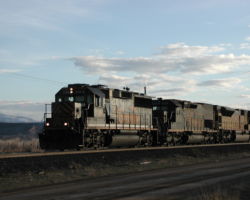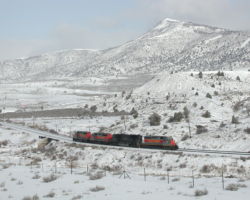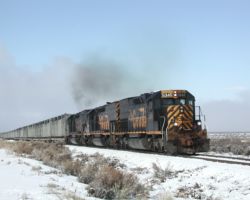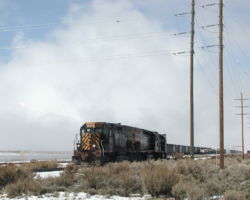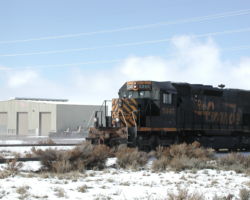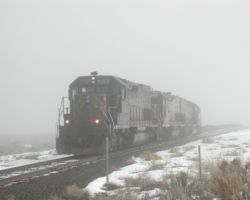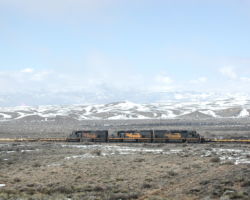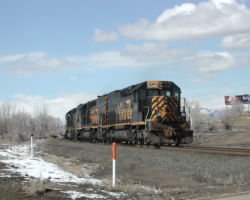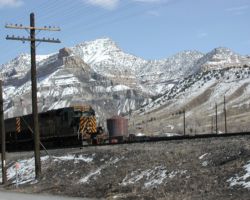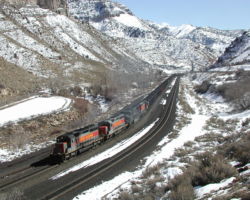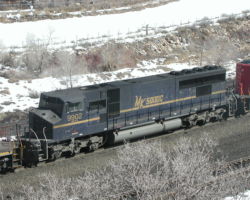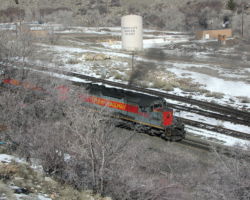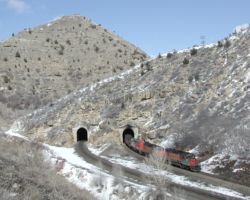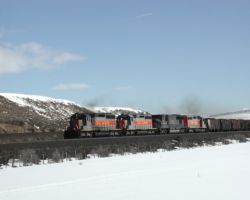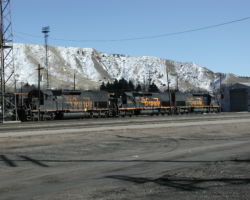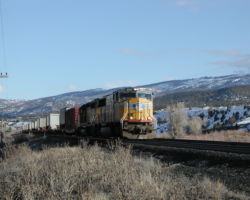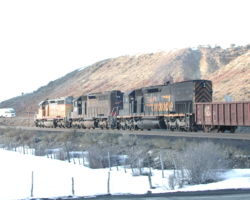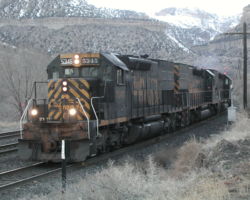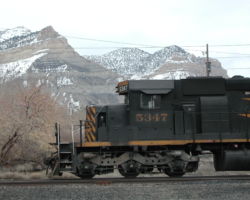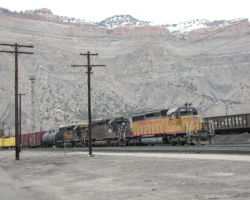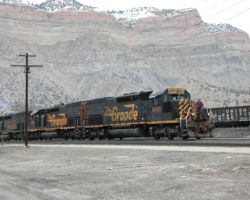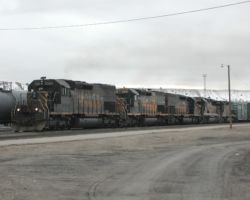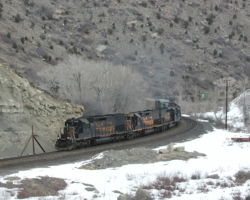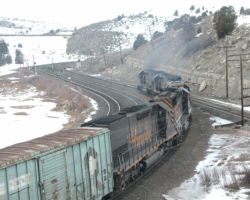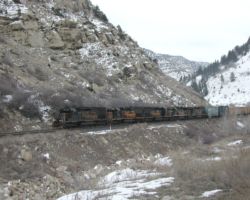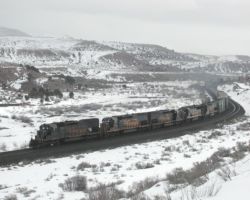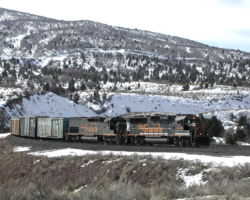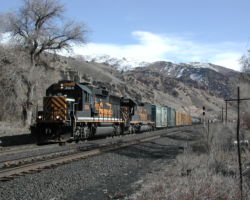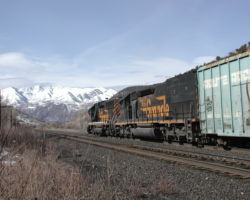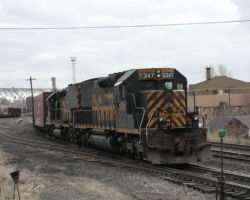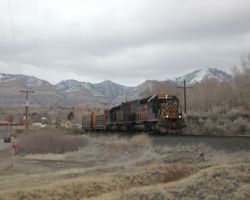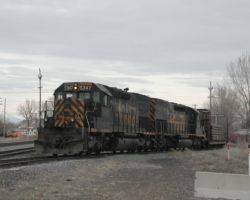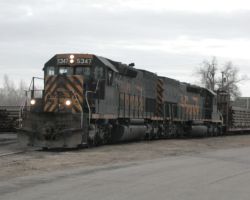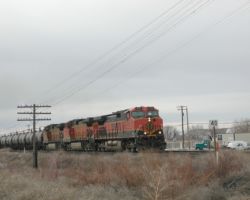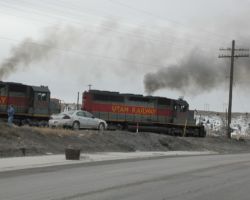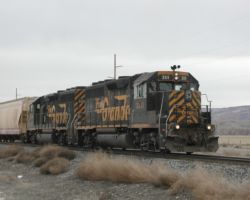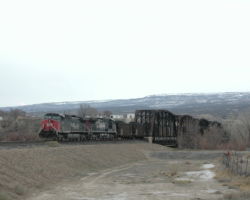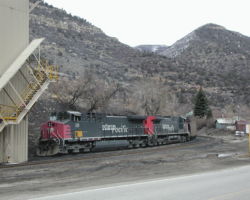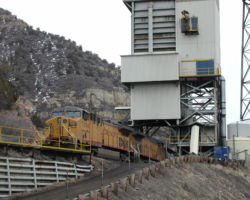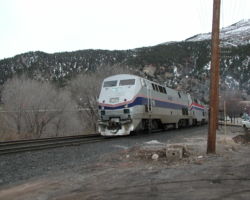With UP rapidly deploying distributed power over Soldier Summit, it’s common knowledge that the days are numbered for the large group of D&RGW SD40T-2 Tunnel Motors stationed in Helper, UT. As work is gearing up for a few months of intense efforts, I decided that this last weekend (March 2-5, 2001) was probably my best chance to take in these final days. So, around noon Friday, I took off for 3 1/2 days of black and gold railfanning fun. Included are a Dirt Train up the Sunnyside branch running with three T-2s, a westbound MDVRO with five Grandes on the point, the usual assortment of Utah Railway and BNSF action, and a few of the newer DPU-powered coal trains thrown in for fun. Also included are a a meandering trip home, including a Grande-powered local working out of Grand Junction and a side trip down the North Fork Branch.
Getting There and Saturday Morning Dirt – March 3, 2001
After quickly finishing up some work Friday morning (including some that suspiciously appeared from nowhere as soon as I announced I was taking off in the afternoon), I jumped in the new truck and headed off for Helper. I was mainly concerning with just getting there, as it’s about a 7 hour trip from Colorado Springs if everything goes well, and additionally the only moving Rio Grande power of interest was DRGW 3154 and 5356 on an eastbound manifest. The last trace I’d seen before leaving was Grand Junction, CO, at 11:30ish, so I assumed by the time I got anywhere close to the main line, they’d be long gone on their trip to Denver.
While not of great interest (not to mention not backed with any photos at all), I did meet Amtrak #5 at the east end of Glenwood Canyon. Being that it was around 3 in the afternoon, the only thing surprising was that #5 was nearly on time. The part I couldn’t reconcile, though, was the fact that the dispatcher kept talking to #6! Then, when the meet between #5 & #6 was called for one of the sidings (Grizzly, I believe), the light finally went on inside my dense head – with #6 running around two hours late, the Zephyrs would meet in Glenwood Canyon, just like all those photos I’ve seen from years ago when it was the real CZ! Sure enough, rolling around the corner was #6, powered by three Genesis units and an F40PH in Phase IV paint (404, I believe, though I was busier driving than memorizing unit numbers). Other than that, the line to the west of Glenwoood seemed pretty barren, except for the usual parked coal train here and there. In all fairness to UP, I only remember seeing one, but can’t remember for the life of me where exactly (Chacra, maybe?)
Assuming the worst – now there’s something I should really learn not to do. As anyone who’s ever read one of these trip reports knows, that’s not how my luck works. Some days I swear I’ve got this insane amount of luck when it comes to railfanning – it just really amazes me how well things always seem to work out and how good my gut instinct is at finding not just trains in general, but the right trains. Of course this just could be a sign that I’ve been at this too long, but we’ll ignore that possibility. Either way, it doesn’t take much to figure out that 3154/5356 hadn’t slipped past me, despite I couldn’t see how they were still to the west.
The first place I actually heard radio contact with a DRGW-lead eastbound was just east of Debeque, CO. East of Debeque, I-70 and the former D&RGW main diverge for some miles, which makes it very easy to miss trains through this section. I was just approaching the point where the two come back together (and cross, for that matter), and assumed that the Grandes had slipped past where I couldn’t see them. The reasoning behind that was the signal was coming in extremely clearly, which for those of you who don’t carry a scanner means the train is typically within 5-10 miles (at least with my hardware and antenna). Of course the scanner crackled out just as the crew gave their position…
Finally, about ten miles down the road, I got the first piece of usable information – I heard them discussing where to meet the westbound Amtrak (#5). The initial thought was that the eastbound DRGW3154 was not going to make it in the hole in time at Tunnel, so the dispatcher was going to take him back to Cameo (apparently he was stopped just a few cars over the west switch – as I understood the broken-up radio conversation, at least). However, the two finally agreed that Tunnel was possible, as #5 was just clearing a meet at Grand Valley. So, without much choice (there isn’t much in the way of exits between Debeque and Cameo, aside from two that aren’t very useful in terms of railfanning), I decided to head on and see how far he’d gotten past Cameo.
As it turns out, I almost beat him to the crossing by the Cameo generation plant. The only shot I actually got though was one of him departing east, and it was obscured by UP trucks and other equipment. Lousy shot, went to the reject queue when I sorted the photos for the trip. Back to Debeque we go… I was a little concerned, though, after my last experience with Rio Grandes in later afternoon light in Debeque – I’d never found a good place to photograph eastbounds there, but I didn’t want to chase him any further back. Light was already starting to fade, and a few clouds on the horizon would quickly start to obscure the sun.
As it turns out, there’s a road leading southwest out of Debeque I’d never noticed before. I should really learn to actually use all those maps I carry around someday. The thing is, though, that I never remember them in times of crisis, such as when I have two eastbound Grandes bearing down on me and failing light – not exactly the time I want to be out hunting for new shots. Anyway, for those of you who’d like to know where it is, it appears to come off second street as you continue west (Now I’m relying on the maps – I don’t remember firsthand). It eventually dead ends, but will take you down along the track for some ways west of town. I sat there for only seven minutes or so before the sound of hard-working EMDs could be heard in the valley around the corner. Shortly, 3154 and 5356 came into view, along with a trailing SD9043MAC and the rest of MRODV-01. It turned out not the best shot in the world, but with two Grandes on the front it helps make up for the lighting difficulties. (Photo 1)
The rest of the trip into Price for the evening was relatively non-eventful. The only other train I actually saw was a BNSF local headed west out of Grand Junction to serve some unknown customer. I never got as far as Helper itself, since after I’d checked into my hotel (the Best Western in Price), it was starting to snow fairly heavily. I decided to just call it a night and tackle Helper in the morning.
The morning proved interesting – despite weather forecasts of clear skies and mid-50s temperatures, everything was covered with several inches of snow when I woke up. However, unlike Colorado, where the snow comes in horizontally and gets preceeded by a sheet of ice, all the snow was neatly piled on top of the truck. A few seconds with a brush on the windshield was all it – no ice, no snow on the sides. Nice – think I could get used to this! However, the sky was still dreary and overcast, unlike the blue I’d expected. Nonetheless, I figured I’d stop by Helper and then head up the hill to see what was moving.
Helper was exactly what I expected – five tunnel motors neatly sitting around idling. No sign of anything, so I headed out towards the Summit. I did notice on the way past the north end of Helper that the Utah Railway helpers appeared to be gone, and so I had some hope there would be something to see. Fortunately, approaching the summit, the skies cleared significantly. Just north of Kyune, four Utah helpers came into view, so a with a quick pull-off I managed to get my first real photos for the trip. (Photo 2) For reference, the consist was (from nearest to furthest) UTAH 9009, MKEX 9902 (an MK5000C, for those who haven’t seen one before), UTAH 9006 & 9007.
It was only seconds after I climbed back in the truck that I heard a track warrant issued to DRGW5345 east at Wellington for permission to operate over the Sunnyside Branch. There was really only one thing this could be – the so-called Dirt Train, a 6-days-a-week run of Salt Lake City trash to the ECDC landfill facility at Sunnyside, usually powered by tunnel motor sets out of Helper. After muttering something I won’t repeat here, I quickly headed back where I’d just come from – Price, UT, and points southeast. How they got the trash train hooked up so quickly and down to Wellington I’ll never know, but it made me wish I’d stuck around Helper just a bit longer. Most of the line from Price down to Mounds (where the Sunnyside branch connects) is high speed running – 50 to 60 for freights – so I had some concerns whether I’d be able to make it down ahead of him or not. (Especially considering the sun was now out, the roads were getting messy, and I had just run out of windshield washer fluid. A stop for that in Wellington was an absolute must.) Fortunately, the entire branch is limited to 10-20mph, and I hadn’t heard him pass through Mounds itself yet.
Now all this would just be too easy, so the weather decided to warm up just enough to get nice thick fog where US 6 and the Sunnyside Branch cross. I actually missed the road out to Sunnyside the first time and as a result had to go over the branch and turn around. Upon coming back across the overpass I looked down to see six headlights looking back at me – DRGW 5345, complete with the nose lights on, cutting through the fog with two other T-2s and a load of trash. No real rush, though – slow speed limits are great! The only problem was my unfamiliarity with the whole branch – I had only been out there once before, and hadn’t needed to find a way to take photos because I’d never seen a train.
The only public crossing on the branch is actually just before the fence surrounding the ECDC facility. This conveniently also happened to be beyond the fog bank and out in the sunlight, which also inconveniently made it a mudhole from all the melting snow. Oh well, no big deal, that’s what my truck and my boots are for, right? I made it there with way more than enough time to spare, picked out my shot, and waited. Such a rare opportunity – a pure set of Rio Grandes with the nose light one. Didn’t want to waste it, so I swear I took a shot about every ten feet as they approached, the best of which wound up as Photo 3.
Dirt Trains mainly consist of containerized trash on flatcars, but also sometimes have a few extra cars tacked on the end. The power (5345/5410/5360) dropped the whole train in the yard, pushed an already-delivered set of loaded flats back into a yard track, then cut the flats from today’s train and shoved them in the same siding. At the very last, they coupled on to the non-flatcar loads and pulled them up much deeper into the ECDC facility. (I should mention that ECDC has a set of locomotives for switching all this stuff around within their facility) All this switching made for some interesting photos, such as Photos 4 and 5. As you can see in the previous photos, the thick fog was starting to roll back in and ruin the perfect light and sky. I waited and watched the switching, and got one photo of the light power returning down the branch to Mounds (Photo 6).
Three light RG T-2s is just too good a thing to pass up, however. As luck would have it, the fog had lifted from around Banning and the US 6 overpass, so I decided to catch a few more shots here. (It would appear that the old loadout here is now used for surplus car storage.) After only a few minutes, the three showed up and produced some very nice shots in the sunlight (at 15 mph, I might add!) The downside to this was I managed to tear a quarter-sized hole in my coat when leaping over the gaurdrail. Arg, most frustrating, but fortunately under the arm so it’s easily repaired and not terribly visible. At least it yielded some nice photographs (Photo 7), as did the next time I caught him at Wellington (Photo 8). After this, it was back to Helper for some lunch and to see what else was going on in the yard.
Saturday Afternoon, March 3
Things were slow for a while after the Dirt Train power had returned to the yard (Photo 9), giving me time to gas the truck and catch lunch at the Subway on the north end of Helper. Never quite enough time for lunch on these trips, though, as before I’d even finished my sandwich I noticed a Utah train starting to head up the hill. However, there are some things more important than trains, and lunch is definitely in that category. So, I sat and finished lunch.
As it turned out, he didn’t even make as much progress as I thought he would before I caught up. I actually caught it just west of the coal mine at Castle Gate, UT (Photo 10). The front end power was a similar set to the helpers earlier, except that UTAH 9007 had been replaced with 9005 as the lead unit (I’d heard them discussing replacing it on the scanner, but didn’t actually realize they’d done it until I was looking through the photos for this report).
Also included in the set again was one of the MK5000Cs, definitely an odd-looking piece of motive power (Photo 11). These were originally built by Morrison-Knutsen several years back in an effort to become a third new locomotive builder (behind EMD and GE). The six 5000s that were eventually built didn’t prove at all popular (rumor has it because they had reliability issues and because they would require railroads to stock yet another set of spare parts), and sat idle in Boise for quite some time. The Utah recently purchased all six to replace their leased fleet of SD40-2s (and other weird power), and eventually they will receive Utah paint and numbers. Because they’re built around a Caterpillar diesel engine, they also have a very different sound as compared with any other existing unit (with the exception, possibly, of some Cat-powered Alcos on BC Rail).
Getting back to the present, I did wait around for the helper set on the rear end to pass – another three Utahs. For reference, they were (from front to back): UTAH 9011, 9010, and 9002. From the exhaust pouring out of 9002 (Photo 12), you can guess how hard these units are working! After this, I made only one more stop down in the canyon – at the Nolan Tunnels (Photo 13). This was the only time I’d ever caught a train here when the lighting was right, etc… After that, I went up to Colton to watch the helpers be cut off and the rest of the train continue over the summit (Photo 14) towards Provo.
I’d received word from home via cell phone that there was a westbound M train slowly working its way towards Helper. I do emphasize slowly – it had passed Cisco, UT, almost four hours previous, and I still hadn’t heard anything about it arriving in Helper. I did go back down to look for it, and to get new batteries for the scanner as the old set died while I was watching the Utah Rwy train cut off the helpers. Seeing the usual nothing, and not hearing any indication of anything on the scanner, I decided to take a few more photos of the sitting power in the yard (Photo 15) and then head out west again. (BTW – this is was just dumb. I’d forgotten entirely about the westbound MDVRO at this point. If I would have remembered it, I would have realized that it had to show up eventually and, more importantly, would have realized that it would get helpers for the climb up to the summit.)
Most of the rest of the day was considerably more like I remembered from my last trip to Soldier Summit in July 2000 – slow, sluggish, not much happening. After the messages on the D&RGW list about the T-2 helpers only being used for helping the manifests over the hill, I really hadn’t expected to see as much as I already had today. Nonetheless, I thought I’d venture west towards Spanish Fork and Provo for time being. Mainly just restless and impatient, I guess – bad characteristics when I should be waiting for the T-2s in Helper to be moving.
The trip wasn’t all that exciting – I caught up with the Utah westbound again, saw two of the tunnel-motor-eliminating DPU coal trains, but the lighting was bad on all of them, so I never did stop to take any shots. I did have some limited success on the way back – I caught up with a westbound Z train, led by UP SD70M 4002, at the Narrows crossover, as well as meeting the westbound M (lead by UP 3154) at Colton (Photo 16) – you know, the one I should have been waiting on this whole time… Honestly, when I saw it sitting there, it took seeing DRGW5347 buried in the consist to make me even realize what it was. (Photo 17) I was still recovering from a nasty cold, so I’m going to blame that for messing with my head, rather than the obvious answer (namely, I was being a moron). Then, though my binoculars, I noticed three helpers being cut off and starting to head back down the hill. *At this point, kicking myself repeatedly.*
Actually, despite my blundering, there was just enough light to get a few shots of the helpers travelling light back to Helper. Most weren’t great by any means. Thanks to a slight delay getting them lined into the yard, I did get a decent chance to photograph them from Helper’s north/westernmost grade crossing (my map shows it as Janet Street, either way, it’s clear at the north end of town). Photo 18, while being a bit grainy due to the camera being set with an ISO400 film equivalency, is still much better than I ever could have done with film in this light. Plus, with all six lights on, it’s probably one of my favorite shots for the entire trip.
After this, the light was completely gone, so I went back to my room in Price, ordered a pizza, started sorting my photos for the day, and eventually fell asleep around 10. All in all, a pretty successful day, and more Rio Grande movement than I’d caught in my entire previous trip.
Sunday, March 4
One thing I’d expected to see that I really hadn’t was other railfans. Yesterday (Saturday), I did actually see a couple guys (who I later learned were probably Scott from N Scale Supply & company) on the gravel across from the Nolan Tunnels, but didn’t have time to introduce myself. I don’t remember why I was hurrying, just that I was in a fairly good hurry at the time – quite possibly to catch the Dirt Train. I was expecting to see Frank Keller (also from Colorado Springs) and a friend of his from California, but I hadn’t seen them yet. Not that I’d know what Frank looks like – seems like we always just miss each other when we’re out in the same area. It happened this way a couple weeks back when following the 5389 south down the Joint Line – we just missed each other at Larkspur and Palmer Lake, and I thought maybe we’d managed to do it yet again. However, they were planning on being in town until Friday, then pressing on to Winterail, so there was still a good chance I’d run in to them.
So, I woke up around 0830h, showered, and figured I’d head over to Helper and see what was moving. The first encouraging sign was the end of a westbound manifest sitting at the west end of the yard – however, I wasn’t awake enough to realize my scanner wasn’t on, so I had no idea what was waiting for me on the front. As I got further into Helper, I could see moving helpers, which I expected, and more Rio Grande power already on the front of the train, which I certainly didn’t expect! This particular westbound MDVRO had just DRGW 3154 and 5356 (the same pair I’d seen in Debeque on Friday) for power. Within minutes, Jim Burrill and his wife showed up (Jim I’d first met at North Yard on the trip to follow 5389, and has an excellent site at http://colorado.railfan.net). We talked for a minute, and I learned that the eastbound MRODV-04 was sitting at West Helper, waiting for the three tunnel motors to clear so they proceed into the yard (Photo 19). Evidently they would be exchanging DRGW 5347 (fairly fresh from Burnham, and seen yesterday at Colton) for DRGW 5385 (one that had been in Helper for some time). No word on whether this was due to operational problems or 5385 just needed a regular inspection [Note: As of today, 10-March-2001, 5385 is out on the road again, so I’m guessing that it just needed an inspection or minor work]. Jim, unlike me, had been smart/awake enough to turn on his scanner…
The helper crew backed the usual trio – DRGW 5345/5410/5360 – on to the front of DRGW 3154 and the manifest (Photo 20), and shortly after that Frank and David. As it turns out, they’d spent the previous day around Grand Junction hoping to catch some of the local Rio Grande power in action. The conversation was short-lived, though, because as soon as the eastbound was in the yard, 5360 west started up and headed out of the yard. (Photo 21)
Being a very well-powered train, it really didn’t waste much time and seemed to be able to hold track speed most of the way to the summit. Following it was, at the very least, challenging, especially when you take into account dealing with moderately heavy traffic on US 6 and actually trying to spot locations that make good shots before you overrun the tiny gravel pull-offs along the road. Of course there’s always the tried and true locations, and it surprised me that between the three cars (Frank and David, Jim and his wife, and myself) following 5360 up to the summit, we all picked basically the same spots. I guess it doesn’t matter who you are, some shots are just well known to work… There’s the S-curve above the Nolan Tunnels (Photo 22), the bridge at Kyune (Photo 23), and a whole host of nameless straightaways in-between (Photos 24,25).
The helpers actually got cut off at Colton to head back down the hill. I stopped beside the grade crossing just beyond Colton to wait on the continuing train, in a bit Jim joined up with me. Both agreeing it was a horrible shot, however, due to strange lighting, he headed back down the hill to try to catch some Utah Rwy. movements. He also had to be back home Sunday night, and as such didn’t have the luxury of following the westbound M any further. Frank showed up shortly afterwards, and by this time the helpers were cut off, I was done downloading my camera to my laptop (again…), and things were quickly moving again. Next stop – Gilluly…
It seemed to take forever for 3154 to get from Soldier Summit down to the lower Gilluly loop – fortunately, an eastbound BNSF manifest was climbing up while I was waiting, providing some amusement. Also, the fog and gloom of the south/east side of the pass was starting to break, and there was some pretty good sun at the lower horseshoe curve. Unfortunately, sun means melting snow, and melting snow means one thing out here – mud. Yick, big clods of it stuck to my boots, and I was sliding down the highway embankment because of it. I was already about 90% down, but there were big pools of water at the bottom, so it was in my best interest to avoid that last 10%. I finally managed to find a sizable shrub that I could trample for decent footing, and promptly did so. (I can just hear the environmentalists yelling now…) From that point, it wasn’t much of a wait – 3154 and 5356 showed up shortly, dynamics whining away. (Photo 26).
Over the next ten miles or so, it was a matter of looking for a decent shot. The line really runs far too northeast at this point, making shots around noon fairly difficult. Finally, up around what I believe to have been the Rio crossover, I found a decent shot on the south side of the line, and even a large highway pulloff to put the truck in. Wouldn’t you know, within minutes here come Frank and David again to get the shot, too. (Photo 27) After that and one more shot in the mud at what used to be Thistle, we were off to Provo in search of a DRGW GP40 that was supposedly on local duty up there. Since I’d never been up that far before, I just followed along.
As it turns out, Provo is a fairly interesting yard facility – there’s what appears to be a public road through the middle of it! I was a little skeptical at first, as it seems to literally run through the middle of the yard itself, but after seeing other traffic on it and not seeing any “No Trespassing” signs that appeared to apply to the road itself (and some reassurance from Mr. Keller), I found it a very good way to get extremely close to the action. I should mention that attention to safety is certainly required as several active yard tracks do cross the road, and in fact I got stopped once by a string of six locomotives being moved. Unfortunately, the Rio Grande we were looking for wasn’t in the bunch, so we all headed off to grab some lunch at Wendy’s and proceed with the day. We actually parted ways at this point – I turned back south towards the Summit in hopes of catching more tunnel motors in action, and they headed further north after the GP40 in question. I decided heading back would be more productive, just because even if the tunnel motors were all still idling in the yard, at least there was a westbound BNSF following the MDVRO we’d been chasing, so that held some promise.
As it turned out, the BNSF slipped by me somewhere, probably out of sight near Gilluly or at the Thistle tunnel – I really don’t know. Either way, I never saw it, but did hear radio chatter to/from it a few times. Not that I really cared – I kept telling myself that my primary reason for being here was to watch the T-2s. Upon arriving at Helper, a crew had gotten the smaller set of T-2s out – 5347 (exchanged for 5385 this morning), and 5401 – and was switching the north/west end of the yard with them. (Photo 28) This provided a great many opportunities to watch the motors at close range, and get all the detail photos I wanted. The strange thing is that they kept referring to this switch job as a “local”. Odd terminology, I thought, for something that looked more like a 6000 horsepower yardswitcher. (but a very good looking one, at that!)
Eventually, it took Mr. Keller returning and offering a little insight to Utah operations – this actually was a local, and would probably go switch either Price or the Castle Valley spur after it was done moving stuff around the yard. Specifically, it looked like the loads of pipe would be headed out. Switching the yard took a great deal of time, though, and most of it we spent standing, talking, and watching the two work back and forth with cuts of cars – not to mention the local residents cutting right across the yard. And UP thinks railfans are bad – they should look at the locals sometime! (Admittedly, some in this hobby are complete nutcases, and do really stupid things that endanger themselves and cause the crews undue stress… Of course the dumbest things I’ve ever seen have always been from people who barely know the trains are there, but that’s another story.) The most interesting comment of the day heard over the radio: “There’s so many people out here today, you’d think it was Roper” Gee, if they think the three of us are a lot, I can only imagine what they thought during the big D&RGW list get-together back in January…
After we’d all frozen due to standing out in the cold too long, we all decided to climb back in our vehicles and go have a look around – this whole switching/local thing wasn’t looking too promising to me, and light was really starting to fade with the moderate cloud cover that afternoon. No sooner had I gotten up to the Utah’s yard facilities than I heard the dispatcher give permission to 5401 to work from Helper down to Price. Needless to say, I was back trackside as soon as possible without angering the Helper cop (who, I might add, had been very active over the weekend, and no doubt wondered why the same grey Yukon with Colorado plates kept going through his town 10-15 times a day. I also should point out that the entirety of US 6 from Helper to Spanish Fork is an “Enhanced Enforcement Area” or some such, and consequently appeared to have several Utah State Patrol officers working it at any given time. As far as pulling over for photographs, they didn’t seem too concerned – obviously just exercise caution and be aware that speeding through here is probably a very bad idea. Anyway, just something I felt I should make a note of in the report.)
Despite the high track speed between Helper and Price, the local was only travelling about 35-40, making it a reasonable thing to follow. I actually caught up with it twice – once right south/east of Helper (Photo 29) and then again down by Maxwell. Soon it was stopped in West Price, and needless to say I was right there with it.
The task at hand for the local crew was to fetch two empties off of a spur and place the two loads of pipe in their place. This was only made difficult by the fact that the switch to enter the siding faced west – ie, the cars were on the wrong end of the locomotives. So, the crew dropped the cars at the west end, did a run-around through East Price, coupled up and backed the whole thing down to pick up the empties (Photo 30). Then, they pulled the empties back out onto the siding, dropped them, and spotted the loads back in their place (Photo 31). All the while, the three of us were standing in the public park next to the siding watching the whole thing. Finally, around 1800h, they had the empties coupled on, brake test done, and everything was ready to go for a trip back to Helper. After all, we’d heard on the radio they needed one of the two tunnel motors around 2000h when the dispatcher was planning on having four out of the five available to push a coal train up the hill. Why does all the good stuff happen after dark?
Monday, March 5 – The Trip Home
Monday started a lot like Sunday – dreary, cold – except 24 hours closer to going back to work. Not necessarily a bad thing, as after four days off I was relaxed enough to handle almost anything, but I still had the day and I was bound and determined to pack as much Grande action in as humanly possible. However, it wasn’t even UP the day started out with – it was BNSF 1012, leading a westbound manifest just outside of Price in Maxwell, UT. (Photo 32)
Not surprisingly, UP doesn’t furnish pusher horsepower to BNSF trains that can’t make it over Soldier Summit, so the Utah is happy to step in and “help out”, no pun intended. As the train came in to East Helper, it met a set of D&RGW tunnel motors on their way out to Sunnyside with another Dirt Train, as well as Utah 9010 and 9002, ready to be coupled on the back. Apparently, I wasn’t watching closely enough, and the Sunnyside local slipped out of the yard without my notice. Oh well – only 5401 and 5347 again, I’d seen them a great deal yesterday. So I thought I’d wait around for the BNSF to depart, and in hindsight I’m quite glad I did. The two Utah SD40-2s at the end of the train were running harder than any set I’d seen in quite some time as they came through Helper belching huge plumes of exhaust. (Photo 33)
At this point, I decided it looked like a slow day on the Wasatch Range due to Track & Time permits being handed out to track inspectors and work crews like candy to kids on Halloween, and I had no particular desire to follow the BNSF up the canyon. So I headed out towards Wellington in hopes of catching up with the Dirt Train again. The weather was still dreary and disgusting at Sunnyside Junction, though, so I just continued south and east towards Grand Junction.
The whole way back I only saw one train – a westbound UP manifest with two 70Ms on the front. Other than that, the radio was buzzing with traffic from hyrail trucks, so I didn’t really see any need to stop and check things out. However, approaching Fruita (Colorado – just east of Grand Junction, for those who don’t know), I looked over and had to take a second, and third, glance to make sure I really saw it – two Rio Grande GP40s pulling a westbound! Needless to say, I was off the freeway and working back along the line very, very quickly – basically I got lucky and had a ramp right in front of me as I saw them.
As it turns out, DRGW 3111 & 3126 were working a local west of Grand Jct. that afternoon, and at the moment were about to start working a large chemical facility just east of Fruita (Photo 34). It appeared they had several tank cars to be spotted there, as well as several flats full of trash containers, most likely bound for the unload facility in Cisco, UT, sometime later in the afternoon. While I didn’t notice it at first, Frank’s car was also sitting beside the track. (How exactly they beat me here I don’t know – they were still sitting in the Helper yard watching the BNSF when I left, and I hadn’t really made any stops since…) Turns out they had decided to come east and catch some of the locals out of GJ as well, including a Minturn Local called for 1400h that afternoon, quite possibly with DRGW 5371 and 5372 on the front. While I didn’t have time to stick around for that (well, I did, but didn’t feel like it), they also pointed out that DRGW 3060 was tracing at Arco, CO, which we understood to be a mine out on the North Fork Branch (possibly we’re wrong on this point, considering I never found it?). Nonetheless, at the time, that was all the excuse I needed to go exploring the North Fork. After all, I’d never been down that way – so what if it’s twice as long to get to Glenwood, I’m in no hurry.
I decided to do a bit of poking around GJ first, though, especially considering I was going to need gas anyway. Nothing really accessible of note, except a loaded coal train coming off the North Fork branch I noticed as I was about to leave town (Photo 35). After that it was to Delta, nothing I saw here looked particularly appealing for food, and I wasn’t that hungry… yet. But by the time I got to Delta (only about 30 miles), I was ready to consume literally anything that was edible and within my grasp. Being in a bit of a hurry at this point, I decided to go for the nearest thing – McDonalds – a decision I lived to regret the rest of the afternoon. Since swearing off most greasy fast food quite a while ago, my system doesn’t react well when I do dumb things like this – after all, what can a Big Mac hurt, anyway? Uggh, four hours of an aching stomach really puts a damper on any desire to chase anything down.
As far as the North Fork Sub goes, it looks like the whole thing is under construction (mainly because it is…). I met a cleanup train (one GE on the front, a set of gons with cranes picking up scrap, and a caboose in UP MoW green on the back) just west of Delta, and this was just the start. All the way up to Hotchkiss there were literally men and machines everywhere – changing ties, rail, whatever. My understanding is that UP is trying to raise train speed to 40 from 20 and allow the railway to better handle the large, heavy trains that roll down it continuously, and by the looks of things they’re doing a very good job of it.
Despite carefully checking sidings and house tracks everywhere, there was no sign of 3060. However, I did run into my first coal train tied down at a mine near Paonia, powered by UP 6777 and 7044. No decent photos of it to speak of, though, as it was tucked inside the loadout facility. Slightly up the line at Somerset (and almost at the end), there’s a loadout literally right in the middle of town. Parked just on the far side was SP 119 & 153 with a loaded train (Photo 36). Presumably they were tied down here on the loadout track until the MoW crews cleared the line that evening. Then, just a little further up the line (and at the end), was another train sitting under a mine loadout, this one powered by UP 7084 (Photo 37) and looking empty (though I didn’t get a good look – Photo 37). After that, the only other rail line I saw until Glenwood Springs was the old Aspen branch, and there doesn’t look to have been anything through Carbondale in quite some time, as the flangeways are completely full of dirt and rocks.
Of course, arriving at Glenwood, what trip would be complete if I didn’t see at least one Amtrak move through here? Today it would be #5, powered by Amtrak 19. (Photo 38) There’s not much else to say – the rest of the trip home was cold, boring, and every once and awhile, snowy. By the time I hit the Joint Line, it was already dark.
This work is copyright 2024 by Nathan D. Holmes, but all text and images are licensed and reusable under a Creative Commons Attribution-NonCommercial-ShareAlike license. Basically you’re welcome to use any of this as long as it’s not for commercial purposes, you credit me as the source, and you share any derivative works under the same license. I’d encourage others to consider similar licenses for their works.
